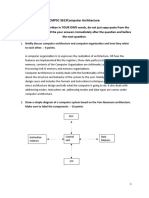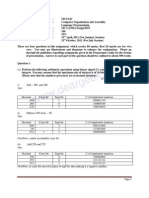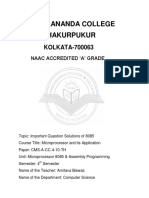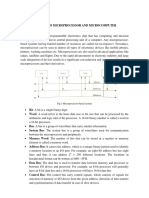Coa Mid
Coa Mid
Uploaded by
mulugetahiluf995Copyright:
Available Formats
Coa Mid
Coa Mid
Uploaded by
mulugetahiluf995Original Title
Copyright
Available Formats
Share this document
Did you find this document useful?
Is this content inappropriate?
Copyright:
Available Formats
Coa Mid
Coa Mid
Uploaded by
mulugetahiluf995Copyright:
Available Formats
መቐለ ዩ ን ቨ ር ስ ቲ
MEKELLE UNIVERSITY
ኢን ስ ቲ ቱ ት ቴ ክ ኖ ሎ ጂ መቐለ
MEKELLEINSTITUTE OF TECHNOLOGY
Computer Organization And Architecture [COA] Mid Term Exam.
Weight 30%
Time given 2 hours
Date December 28, 2018
Full Name ____________________________ ID ____________ dep’t _______
Instructions
Make sure 2 pages
Cheating in exam is forbidden
Mekelle Institute Of Technology Semster I : Mid Examination Page 1
Part I: Short Explanation Questions[3pts each]
1) Explain how processor is enabling program execution. Describe difference between program, and
instruction.
CPU is executing programs through fetch decode execute cycle. To makes the program
execution faster CPU can has multitasking principle that while the first instruction is
executing the next instruction will be loaded (fetched from memory).
Here, program is collection of instructions but instruction is one state of execution by
processor.
2) Explain the differences between vonNeumann versus Harvard architecture. Sketch diagrams for
each of these structures.
The abandon architecture vonneuman is when the data and address buses are connected in
the same line of transfer but with scheduling transfer.
Harvard architecture notices that data and address buss are in separate line of connections
so that data and address will be transferred at the same time
3) Explain how registers communicate with memory busses.
Dues to set of complexities happen to connect register each other.
Have one centralized set of circuits for data transfer – the bus. Have control circuits to select
which register is the source, and which is the destination
Bus is a path (of a group of wires) over which information is transferred, from any of several
sources to any of several destinations. Transfer will be possible From a register to bus or
among registers: BUS R
Mekelle Institute Of Technology Semster I : Mid Examination Page 2
Part II: Long Explanation Question[4pts each]
1) Suppose an architecture where address bus is 32 bits, data bus is 16 bits. As a programmer of java
code lets integer size is 8 bits. Draw a memory layout if you enter decimal number “243435”. Let
for simplicity starting memory address is 00000008.
For simplicity Answer sheet, The decimal number 243435 is 18 bit number as follows = 11 1011
0110 1110 1011
If size of data bus is 16 bit, this implies that 16 bit data will be transferred from memory to CPU
(registers) at once (clock time of the processor).
Hence, it is expected to say that the other two bits of the decimal number above will be
stored/read in the next instruction call.
00000008H stores 1011 0110 1110 1011
00000009H stores 0000 0000 0000 0011
Unfortunate due to size of integer data size is 8 bits here, the maximum integer number we can
accept in java is 28=256. The integer number we gave to java compiler will run overflow error.
2) Let you have calculator application in your system. You let open the application and you type
2+7
= 9. Answer the following Questions
i. Explain what is function of Operating system here
ii. Explain what is function of CPU here
iii. Explain what is the function of RAM here
OS is a system program in our computer that manages every hardware and software
resources. OS allows application programs to run over it. Here, CALCULATOR
application with its Graphical user interface/view and set of active buttons is developed
and then installed as part of the OS.
CPU is worker of OS that it will call by OS as one resource. To execute the addition of
2+7, CPU would use through ALU and CU.
RAM will load/read and store/write the result executed by CPU ALU, CU, and registers.
Here, one register stores value 2, another register stores value 7. The result/sum is stored
in Accumulator register by default. And then the value will transfer to RAM to display in
calculator Application.
Mekelle Institute Of Technology Semster I : Mid Examination Page 3
3) The following is 8085 Assembly code. Answer the following Questions.
i. Describe the difference between registers, and instructions
Register is a small storage device that stores bits of data for operation. Registers can be
special and general purpose registers. Instructions are software commands that order the
CPU to do some operations. Instructions enable value of registers to be adjusted
accordingly. For example, ADD B is 8085uP instruction that adds contents of register A
and register B and then store the result in register A.
ii. Describe and list what are general and specific purpose registers.
GP Registers: will function on usual arithmetical and logical operations made by CPU.
Examples Accumulator (A/ACC), BC, HL, DE, etc
SP Registers: will function and called on some special purpose activities by CPU.
Examples MAR< MDR, IR, IRR, PC, SP (stack pointer)
iii. What would be value of MAR and MDR based on the above code
STA instruction stores/writes the value, previously at register A in to memory address
2900H. Here, MAR stores the address in which processor wants to put data in it and
MDR stores the value of that address (content=05)
Thus MAR = 2900. MDR = 0005H are values before updating.
Consecutive running of programs makes updates on register values. LDA instruction
loads/reads data (05) from memory location 2900.
Thus MDR =0005H, MAR = 2900H.
iv. Explain the purpose of Instruction register(IR)
The instruction register (IR) or current instruction register (CIR) is the part of a CPU's
control unit that holds the instruction currently being executed or decoded. IR has three
modes to identify the type of operation is memory mode, register mode and I/O mode.
Hence, in this example once the PC (program counter register holds address of execution
instructions sequentially, IR holds each of above sequential instructions their address is
hold by PC.
Mekelle Institute Of Technology Semster I : Mid Examination Page 4
4) Suppose you have small bag. The bag can be Opened and Closed According to set of 4 buttons -
B1, B2, B3, B4. The BAG be open if you press two (2) of any consecutive buttons but the Second
(B2) button must stayed pressed. Design Open (OP) and Close (CL) logic circuit for this
scenario.
The truth table LOOKS like:
s.N B1 B2 B3 B4 OP CL
0 0 0 0 0 0 1
1 0 0 0 1 0 1
2 0 0 1 0 0 1
3 0 0 1 1 0 1
4 0 1 0 0 0 1
5 0 1 0 1 0 1
6 0 1 1 0 1 0
7 0 1 1 1 1 0
8 1 0 0 0 0 1
9 1 0 0 1 0 1
10 1 0 1 0 0 1
11 1 0 1 1 0 1
12 1 1 0 0 1 0
13 1 1 0 1 1 0
14 1 1 1 0 1 0
15 1 1 1 1 1 0
Open Circuit OP = B2B3 + B2B3B4 + B1B2 + B1B2B4 + B1B2B3 + B1B2B3B4
B2B3(1+B4) + B1B2(1+B4)+B1B2B3(1+B4) = B2B3 + B1B2 + B1B2B3
B2(B3+B1+B1B3) = B2(B1+B3(1+B1)) B2(B1+B3)
And CL = B1’B2’B3’B4’ + B1’B2’B3’B4 + B1’B2’B3B4’+ B1’B2’B3B4 + B1’B2B3’B4’
+ B1’B2B3’B4 + B1B2’B3’B4’ + B1B2’B3’B4 + B1B2’B3B4’ + B1B2B3’B4’
B1’B2’B3’(B4’+B4) + B1’B2’B3(B4’+B4) + B1’B2B3’(B4’+B4) + B1B2’B3’(B4’+B4) +
B1B2’B4’(B3+B3’)
B1’B2’B3’ + B1’B2’B3 + B1’B2B3’ + B1B2’B3 + B1B2’B4’ = B1’B2’(B3’+B3) +
B1’B2B3’ + B1B2’(B3+ B4’) = B1’B2 + B1’B2B3’ + B1B2’(B3+ B4’)
B1’B2(1+B3’) + B1B2’(B3+ B4’)
B1B2 + B1B2’(B3+B4’) B1(B2+B2’(B3+B4’)
Mekelle Institute Of Technology Semster I : Mid Examination Page 5
5) Design a 4 bit adder subtractor logic circuit. Show the truth table and logic diagrams clearly.
A 4 bit adder subtractor, means combinational of addition and subtraction for 4 bit values.
Full adder/subtractor Truth Tables.
The operations of both addition and subtraction can be performed by a one common binary
adder. Such binary circuit can be designed by adding an Ex-OR gate with each full adder as
shown in below figure. The figure below shows the 4 bit parallel binary adder/subtractor
which has two 4 bit inputs as A3A2A1A0 and B3B2B1B0.
The mode input control line M is connected with carry input of the least significant bit of the
full adder. This control line decides the type of operation, whether addition or subtraction.
Cascaded binary adders(4 bit)
When M= 1, the circuit is a subtractor and when M=0, the circuit becomes adder. The Ex-OR
gate consists of two inputs to which one is connected to the B and other to input M. When M
= 0, B Ex-OR of 0 produce B. Then full adders add the B with A with carry input zero and
hence an addition operation is performed.
When M = 1, B Ex-OR of 0 produce B complement and also carry input is 1. Hence the
complemented B inputs are added to A and 1 is added through the input carry, nothing but a
2’s complement operation. Therefore, the subtraction operation is performed.
Mekelle Institute Of Technology Semster I : Mid Examination Page 6
What is inside Full adder now?
Mekelle Institute Of Technology Semster I : Mid Examination Page 7
You might also like
- Solution Manual Computer Organization and Architecture 9th Edition William Stallingsdoc PDF FreeDocument13 pagesSolution Manual Computer Organization and Architecture 9th Edition William Stallingsdoc PDF FreeTuấn Anh Bùi100% (1)
- Certificacion AADocument19 pagesCertificacion AASoporte Fami100% (1)
- Microprocessor and ProgrammingDocument229 pagesMicroprocessor and ProgrammingUbaid Saudagar100% (2)
- Solution Manual Computer Organization and Architecture 9th Edition William StallingsDocument13 pagesSolution Manual Computer Organization and Architecture 9th Edition William StallingsAnubhav50% (10)
- Final Project of Centralized Bill SystemDocument95 pagesFinal Project of Centralized Bill Systemarega alemuNo ratings yet
- Samsung Ua32f6400ar Ua40f6400ar Ua46f6400ar Ua55f6400ar Chassis U85a PDFDocument130 pagesSamsung Ua32f6400ar Ua40f6400ar Ua46f6400ar Ua55f6400ar Chassis U85a PDFHamza Abbasi100% (1)
- Basic Introduction Automation Testing With Katalon StudioDocument35 pagesBasic Introduction Automation Testing With Katalon Studioiskandar salehNo ratings yet
- Fabbc9: Convert Hexadecimal To BinaryDocument11 pagesFabbc9: Convert Hexadecimal To BinaryShan NavasNo ratings yet
- Computer Organization: Sandeep KumarDocument117 pagesComputer Organization: Sandeep KumarGaurav NNo ratings yet
- Mpi 11002Document21 pagesMpi 11002alkesh.eng0% (1)
- Microprocessor BC 0046Document50 pagesMicroprocessor BC 0046ubuntu_linuxNo ratings yet
- Architecture 2020Document10 pagesArchitecture 2020honey arguellesNo ratings yet
- Emb C QB - Unit IiiDocument15 pagesEmb C QB - Unit IiiANANTHI SNo ratings yet
- Microprocessor 8085Document25 pagesMicroprocessor 8085hetal_limbaniNo ratings yet
- Mcs-012 Solved Assignment Ignou 2012Document28 pagesMcs-012 Solved Assignment Ignou 2012Jaimy Ranjith50% (2)
- ELEC 2441 - Computer Organization and MicroprocessorsDocument18 pagesELEC 2441 - Computer Organization and MicroprocessorsBillyNo ratings yet
- Intel 8085 8-Bit MicroprocessorDocument58 pagesIntel 8085 8-Bit MicroprocessorMOHSIN BHATNo ratings yet
- Important Question Solutions of 8085 - ComputerSCDocument59 pagesImportant Question Solutions of 8085 - ComputerSCParamartha BanerjeeNo ratings yet
- Lecture 12: More On Registers, Multiplexers, Decoders, Comparators and Wot-NotsDocument5 pagesLecture 12: More On Registers, Multiplexers, Decoders, Comparators and Wot-NotsTaqi ShahNo ratings yet
- MICROCOMPUTERDocument12 pagesMICROCOMPUTERneshmuneneeNo ratings yet
- IT225: Computer Organizations: August 25, 2014 (Monday)Document12 pagesIT225: Computer Organizations: August 25, 2014 (Monday)skiloh1No ratings yet
- 8085 Important Short Questions (Part-1)Document11 pages8085 Important Short Questions (Part-1)Ln Amitav BiswasNo ratings yet
- MM Assignmemt 1Document10 pagesMM Assignmemt 1ALL ÎÑ ÔÑÈNo ratings yet
- MP Note OldDocument25 pagesMP Note OldBipin BhattaNo ratings yet
- Embedded Systems 220 Control Unit Design Notes: PC: PC + 1 PC: PC PC: Operand PC: PC + OperandDocument3 pagesEmbedded Systems 220 Control Unit Design Notes: PC: PC + 1 PC: PC PC: Operand PC: PC + OperandMahesh JangidNo ratings yet
- Unit - 1 and 2: B.E.,/B.Tech., Electronics and Communication Engineering Reg 2008Document6 pagesUnit - 1 and 2: B.E.,/B.Tech., Electronics and Communication Engineering Reg 2008D Geetha DuraiNo ratings yet
- Microprocessors and Assembly Language EC4121: Lecture 1: Introduction By: Mohamed Elnourani 0911471315Document27 pagesMicroprocessors and Assembly Language EC4121: Lecture 1: Introduction By: Mohamed Elnourani 0911471315divine serpentNo ratings yet
- Part2 Expr03Document10 pagesPart2 Expr03akaka1392781No ratings yet
- Sap-1 ArchitectureDocument9 pagesSap-1 ArchitectureAshna100% (1)
- Intel 8085Document6 pagesIntel 8085Prakhar SrivastavaNo ratings yet
- Mpi LabDocument21 pagesMpi LabmajorjawarpartapNo ratings yet
- Micro ControllerDocument26 pagesMicro Controllerraj_vis321No ratings yet
- MicroprocessorDocument51 pagesMicroprocessorAnonymous oUoJ4A8xNo ratings yet
- Microprocessor and Architecture Solution PDFDocument23 pagesMicroprocessor and Architecture Solution PDFKarmaveer Bhaurao Patil CollegeNo ratings yet
- Assignment 5 CSDocument15 pagesAssignment 5 CSAbelbeen ethioNo ratings yet
- 6.coa Unit 2 Part 2Document25 pages6.coa Unit 2 Part 2my storiesNo ratings yet
- Unit 3Document55 pagesUnit 3reema yadavNo ratings yet
- CO Unit 2-2Document19 pagesCO Unit 2-2Aravinder Reddy Suram0% (2)
- Microprocessor LectureDocument7 pagesMicroprocessor LectureMuhammadAbbasJafriNo ratings yet
- CPU Design Documentation SampleDocument27 pagesCPU Design Documentation SampleJoseph Kerby J. NavaNo ratings yet
- Computer Organization and Architecture (COA) DEC 2017 Solved Question PaperDocument31 pagesComputer Organization and Architecture (COA) DEC 2017 Solved Question PapermaharshisanandyadavNo ratings yet
- Elec 263 Computer Architecture and OrganizationDocument4 pagesElec 263 Computer Architecture and Organizationbebo_ha2008No ratings yet
- Microcontroller - PDF 1411210674Document27 pagesMicrocontroller - PDF 1411210674Anney RevathiNo ratings yet
- Intel 8085Document58 pagesIntel 8085michaeledem_royalNo ratings yet
- Introduction To Microprocessor and Microcomputer ArchitectureDocument6 pagesIntroduction To Microprocessor and Microcomputer Architecturesri vatsaNo ratings yet
- Microprocessor 8085 ArchitectureDocument8 pagesMicroprocessor 8085 ArchitectureHarjot KaurNo ratings yet
- MicroprocessorDocument7 pagesMicroprocessorEjay BildanNo ratings yet
- MI - Assignment - 2023-24Document17 pagesMI - Assignment - 2023-24muskanbandariaNo ratings yet
- Microprocessor Lecture 1Document4 pagesMicroprocessor Lecture 1rspahlobNo ratings yet
- Computer Applications and ManagementDocument11 pagesComputer Applications and ManagementParag PaliwalNo ratings yet
- 8085 MicroprocessorDocument38 pages8085 MicroprocessorPrateek PandeyNo ratings yet
- Logical OperationsDocument6 pagesLogical OperationsLysergic WarNrumorNo ratings yet
- Digital Design Using Microcontroller (1 Week) : 1. ObjectDocument14 pagesDigital Design Using Microcontroller (1 Week) : 1. ObjectntasdeptraiNo ratings yet
- 2 Marks Questions and Answers Ec65-Microprocessor and MicroconrollersDocument19 pages2 Marks Questions and Answers Ec65-Microprocessor and MicroconrollersAnonymous 3XeTp7drNo ratings yet
- 2 Marks Questions and Answers Ec65-Microprocessor and MicroconrollersDocument19 pages2 Marks Questions and Answers Ec65-Microprocessor and MicroconrollerstaksasNo ratings yet
- The Elements of Computing Systems, second edition: Building a Modern Computer from First PrinciplesFrom EverandThe Elements of Computing Systems, second edition: Building a Modern Computer from First PrinciplesNo ratings yet
- Practical Reverse Engineering: x86, x64, ARM, Windows Kernel, Reversing Tools, and ObfuscationFrom EverandPractical Reverse Engineering: x86, x64, ARM, Windows Kernel, Reversing Tools, and ObfuscationNo ratings yet
- Preliminary Specifications: Programmed Data Processor Model Three (PDP-3) October, 1960From EverandPreliminary Specifications: Programmed Data Processor Model Three (PDP-3) October, 1960No ratings yet
- Test Glo-Qc-Tm-0729Document5 pagesTest Glo-Qc-Tm-0729Anonymous IVUj0uiNo ratings yet
- Kafka RemanereDocument3 pagesKafka RemanereRicardo BenavidesNo ratings yet
- Online Bus Ticketing and Reservation System (OBTRS) : Submitted byDocument35 pagesOnline Bus Ticketing and Reservation System (OBTRS) : Submitted byAhsan RazaNo ratings yet
- Three ChaptersDocument13 pagesThree Chaptersisarag19No ratings yet
- IC Compiler™ II Multivoltage User GuideDocument217 pagesIC Compiler™ II Multivoltage User GuideThai Nguyen100% (1)
- Teamcenter Document ManagerDocument11 pagesTeamcenter Document ManagerManelVazquezNo ratings yet
- Comp ReqDocument10 pagesComp ReqMohammed MohiuddinNo ratings yet
- 2-Unidad 2Document48 pages2-Unidad 2juscatNo ratings yet
- Solution For MicroprocessorDocument5 pagesSolution For Microprocessoryash7840gaikwadNo ratings yet
- تﺎﻣﻮﻠﻌﻤﻟا ﺔﯿﺒﺳﺎﺤﻤﻟا مﺎـﻈﻧ ACCOUNTING INFORMATION SYSTEM ﺭﻮﺘﻛﺪﻟﺍ ٢٠١١ ﺔﻌﺒﻁﻟﺍ ﺔﻴﻨﺎﺜﻟﺍ ﺩﺎﻳﺯ ﻢﺷﺎﻫ ﺎﻘﺴﻟﺍDocument216 pagesتﺎﻣﻮﻠﻌﻤﻟا ﺔﯿﺒﺳﺎﺤﻤﻟا مﺎـﻈﻧ ACCOUNTING INFORMATION SYSTEM ﺭﻮﺘﻛﺪﻟﺍ ٢٠١١ ﺔﻌﺒﻁﻟﺍ ﺔﻴﻨﺎﺜﻟﺍ ﺩﺎﻳﺯ ﻢﺷﺎﻫ ﺎﻘﺴﻟﺍEtudiant ProNo ratings yet
- Assignment Information Security Group 3Document5 pagesAssignment Information Security Group 3Abdul Manan SajidNo ratings yet
- Hacking Module 16Document28 pagesHacking Module 16Jitendra Kumar Dash100% (1)
- كتاب تعلم لينكس للمبتدئين PDFDocument96 pagesكتاب تعلم لينكس للمبتدئين PDFjalil klNo ratings yet
- Learning Cyber Security and Machine Engineering at The UniversityDocument6 pagesLearning Cyber Security and Machine Engineering at The Universitydoa ibuNo ratings yet
- Billing IntegrationDocument74 pagesBilling IntegrationRajib BoseNo ratings yet
- Super Important Questions For BDA-18CS72: Module-1Document2 pagesSuper Important Questions For BDA-18CS72: Module-1SamarthNo ratings yet
- Guidelines-for-Online-RCMC (Latest)Document4 pagesGuidelines-for-Online-RCMC (Latest)kp parekhNo ratings yet
- ST Thomas Aquinas College Erepi S.5 Ict End of Term Two ExamsDocument8 pagesST Thomas Aquinas College Erepi S.5 Ict End of Term Two ExamsWANYOTO JULIUS KADOOLINo ratings yet
- Grade 12 - Data Handling Using Pandas 1-Worksheet 1Document2 pagesGrade 12 - Data Handling Using Pandas 1-Worksheet 110B Zoya GousNo ratings yet
- Section 3: CorrectDocument3 pagesSection 3: CorrectmisbahulNo ratings yet
- Tearaway Elk Blank PapercraftDocument3 pagesTearaway Elk Blank PapercraftcraftieNo ratings yet
- Festolx Brochure A4 enDocument6 pagesFestolx Brochure A4 enBenjie DucutNo ratings yet
- Lincoln Power Wave 1000Document12 pagesLincoln Power Wave 1000Luis Ambrosio Hernandez PalaciosNo ratings yet
- CIS Google Kubernetes Engine (GKE) Benchmark v1.0.0Document388 pagesCIS Google Kubernetes Engine (GKE) Benchmark v1.0.0arvindNo ratings yet
- Identity Manager Drivers 4.8: G Suite Driver Implementation GuideDocument80 pagesIdentity Manager Drivers 4.8: G Suite Driver Implementation Guidea a aNo ratings yet
























































































